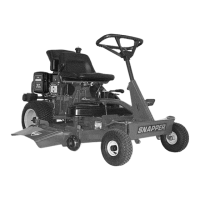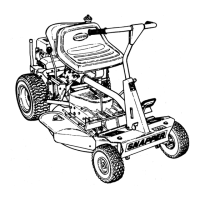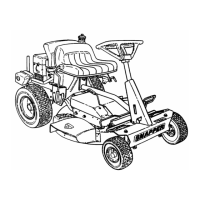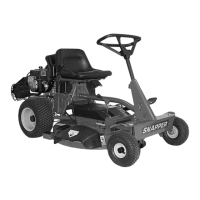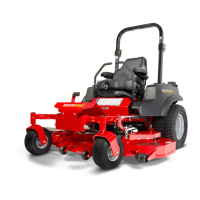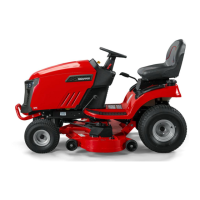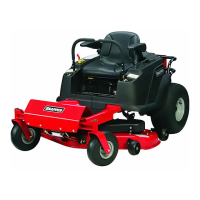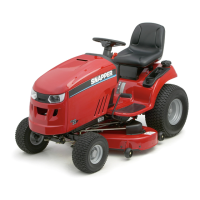5
2. Mow only in the daylight or with good artificial light,
keeping away from holes and hidden hazards.
3. Be sure all drives are in neutral and parking brake is
engaged before starting engine. Only start engine from
the operator’s position. Use seat belts if provided.
4. Be sure of your footing while using pedestrian controlled
equipment, especially when backing up. Walk, don’t
run. Reduced footing could cause slipping.
5. Slow down and use extra care on hillsides. Be sure to
travel in the recommended direction on hillsides. Turf
conditions can affect the machines stability. Use caution
when operating near drop-offs.
6. Do not mow in reverse unless absolutely necessary.
Always look down and behind before and while traveling
in reverse.
7. Be aware of the mower discharge direction and do not
point it at anyone. Do not operate the mower without
either the entire grass catcher or the deflector in place.
8. Slow down and use caution when making turns and
when changing directions on slopes.
9. Never raise deck with the blades running.
10. Never leave a running unit unattended. Always
disengage the PTO, set parking brake, stop engine, and
remove keys before dismounting. Keep hands and feet
away from the cutting units.
11. Turn off the PTO switch to disengage the blades when
not mowing.
12. Never operate with guards not securely in place. Be
sure all interlocks are attached, adjusted properly and
functioning properly.
13. Never operate with the discharge deflector raised,
removed or altered, unless using a grass catcher.
14. Do not change the engine governor setting or overspeed
the engine.
15. Stop on level ground, lower implements, disengage
drives, engage parking brake, shut off engine before
leaving the operator’s position for any reason including
emptying the grass catchers or unclogging the chute.
16. Stop equipment and inspect blades after striking objects
or abnormal vibration occurs. Make necessary repairs
before resuming operations.
17. Keep hands and feet away from the cutting units.
18. Look behind and down before backing up to be sure of a
clear path.
19. Never carry passengers and keep pets and bystanders
away.
20. Do not operate the unit while under the influence of
alcohol or drugs.
21. Slow down and use caution when making turns and
crossing roads and sidewalks. Stop blades if not
mowing.
22. Use care when loading or unloading the machine into a
trailer or truck.
23. Use care when approaching blind corners, shrubs, trees
or other objects that may obscure vision.
24. To reduce fire hazard, keep unit free of grass, leaves &
excess oil. Do not stop or park over dry leaves, grass or
combustible materials.
Training
1. Read, understand, and follow all instructions in
the manual and on the unit before starting. If the
operator(s) or mechanic(s) can not read English it is the
owner’s responsibility to explain this material to them.
2. Become familiar with the safe operation of the
equipment, operator controls, and safety signs.
3. All operators and mechanics should be trained. The
owner is responsible for training the users.
4. Only allow responsible adults, who are familiar with the
instructions, to operate the unit.
5. Never let children or untrained people operate or service
the equipment. Local regulations may restrict the age of
the operator.
6. The owner/user can prevent and is responsible for
accidents or injuries occurring to themselves, other
people or property.
7. Data indicates that operators, age 60 years and above,
are involved in a large percentage of riding mower-
related injuries. These operators should evaluate their
ability to operate the riding mower safely enough to
protect themselves and others from serious injury.
Preparation
1. Evaluate the terrain to determine what accessories
and attachments are needed to properly and safely
perform the job. Use only accessories and attachments
approved by the manufacturer.
2. Wear appropriate clothing including safety shoes, safety
glasses and ear protection. Long hair, loose clothing or
jewelry may get tangled in moving parts.
3. Inspect the area where the equipment is to be used and
remove all objects such as rocks, toys and wire, which
can be thrown by the machine.
4. Use extra care when handling gasoline and other fuels.
They are flammable and vapors are explosive.
a) Use only an approved container.
b) Never remove fuel cap or add fuel with the engine
running. Allow engine to cool before refueling. Do
not smoke.
c) Never refuel or drain the machine indoors.
5. Check that operator’s presence controls, safety switches
and shields are attached and functioning properly. Do
not operate unless they are functioning properly.
Operation
1. Never run an engine in an enclosed area.
Read these safety rules and follow them closely. Failure to obey these rules could result in loss of control of unit,
severe personal injury or death to you, or bystanders, or damage to property or equipment. This mowing deck is
capable of amputating hands and feet and throwing objects. The triangle in text signifies important cautions
or warnings which must be followed.
Operator Safety
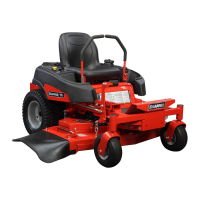
